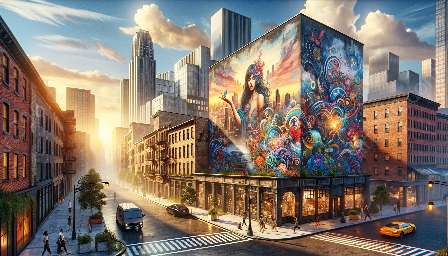Graffiti culture, with its roots firmly planted in urban environments, has evolved to become a powerful force in the world of art, self-expression, and societal reflection. This comprehensive exploration delves into the multifaceted influence of graffiti culture, its compatibility with the evolution of street art, and its impact on urban landscapes.
The Evolution of Street Art
Street art has undergone a remarkable transformation over the years, with graffiti culture playing a pivotal role in its evolution. From its humble beginnings as an underground and often illegal form of expression, graffiti has gradually gained recognition as a legitimate art form. What was once dismissed as vandalism has now become celebrated for its ability to transform public spaces, provoke thought, and spark conversation.
Birth of Graffiti Culture
The origins of modern graffiti culture can be traced back to the streets of Philadelphia and New York City in the late 1960s and early 1970s. It emerged as a form of artistic rebellion and a means for marginalized communities to make their voices heard. Through striking visual imagery and bold lettering, graffiti artists began to reclaim their urban environments and challenge societal norms.
Societal Reflections
One of the most compelling aspects of graffiti culture is its ability to reflect the social and political climate of the times. From poignant messages about inequality and injustice to vibrant murals celebrating diversity and unity, graffiti serves as a visual commentary on the issues that impact communities. Its presence in urban landscapes serves as a powerful reminder of the complex realities faced by city dwellers.
Artistic Expressions
The influence of graffiti culture on the broader street art movement is undeniable. Talented artists have expanded the boundaries of traditional graffiti, incorporating diverse styles, themes, and techniques. From large-scale murals that adorn city buildings to intricate stencil work adorning alleyways, graffiti culture continues to inspire creativity and innovation within the realm of street art.
Impact on Urban Environments
Graffiti culture has left an indelible mark on urban environments, both physically and culturally. While its presence has been met with varying degrees of acceptance and resistance, there is no denying its significant impact on the visual landscape of cities around the world. From rejuvenating neglected spaces to sparking conversations about art and public spaces, graffiti has reshaped the way we interact with our urban surroundings.
Community Engagement
Many communities have embraced graffiti culture as a means of revitalizing their neighborhoods and fostering a sense of cultural identity. Street art festivals, curated mural projects, and public art initiatives have provided platforms for artists to showcase their work while engaging with local residents. The result is a more vibrant and connected urban environment that celebrates the diversity of artistic expression.
Challenges and Controversies
Despite its artistic merit, graffiti culture continues to face challenges and controversies, particularly in its relationship with public and private property. The debate surrounding the distinction between unlawful vandalism and legitimate street art remains contentious, with legal and ethical questions shaping the discourse on graffiti's place in urban spaces.
Conclusion
The influence of graffiti culture is deeply intertwined with the evolution of street art, shaping the way we perceive urban landscapes and fostering a dialogue on artistic expression, societal reflection, and community engagement. As cities continue to evolve, graffiti culture remains a dynamic and influential force that challenges conventions, sparks creativity, and leaves an indelible mark on the fabric of urban life.

